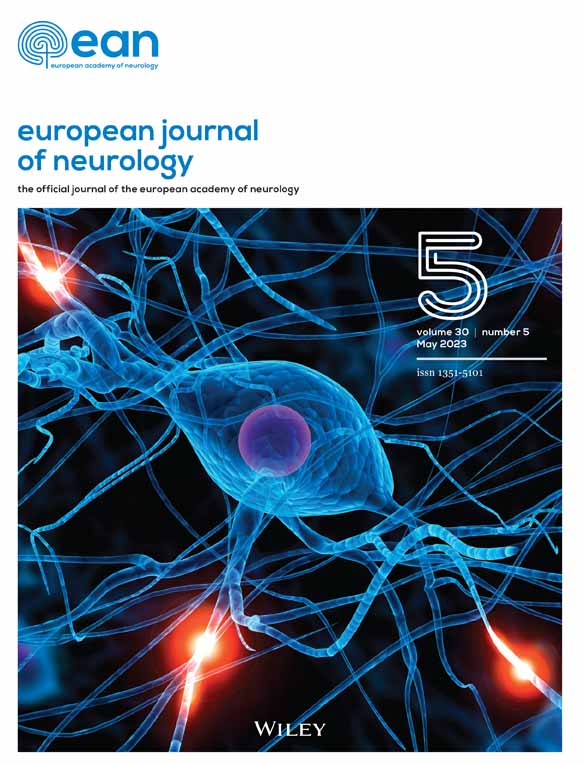Non-ADEM encephalitis in patients with myelin oligodendrocyte glycoprotein antibodies: a systematic review
Enrique Vega and Georgina Arrambide authors contributed equally to this work.
Thais Armangué and Alvaro Cobo-Calvo authors share senior authorship.
Abstract
Background and purpose
Non-(acute disseminated encephalomyelitis) (non-ADEM) encephalitis and/or fluid attenuated inversion recovery hyperintense lesions in anti-myelin-oligodendrocyte-glycoprotein-associated encephalitis with seizures (FLAMES) are rarely described in patients with myelin oligodendrocyte glycoprotein (MOG) antibodies (Abs). The aim was (i) to describe the clinical features and disease course of children and adults with non-ADEM encephalitis and/or FLAMES associated with MOG Abs and (ii) to describe their association with other central nervous system autoantibodies.
Methods
This was a systematic review following the PRISMA guidelines. Patients fulfilled criteria for non-ADEM encephalitis and/or FLAMES, and all were MOG Ab positive.
Results
In total, 83 (79%) patients with non-ADEM encephalitis (48 also had FLAMES) and 22 (21%) with isolated FLAMES were included. At the first episode, children (n = 45) had more infections (11/45, 24.4%; p = 0.017) and more of the phenotype consisting of non-ADEM encephalitis (42/45, 93.3%; p = 0.014) than adults (n = 38). Children had more episodes consistent with working memory deficits (25/54, 46.3%; p = 0.014) but fewer psychiatric symptoms (16/54, 29.6%; p = 0.002). Twenty-eight (40.6%) of 69 patients had N-methyl-d-aspartate receptor (NMDAR) Abs in cerebrospinal fluid (CSF), being more frequent in adults (19/29, 65.5%; p < 0.001). Compared to negatives, positive CSF NMDAR Abs had more relapses (14/20, 70%; p = 0.050), required ventilatory support more frequently (8/34, 23.5%; p = 0.009) and had more psychiatric episodes (28/34, 82%; p < 0.001) or abnormal movements (14/34, 41.2%; p = 0.008). Apart from an older age in FLAMES, positive and negative CSF NMDAR Ab groups shared similar features.
Conclusion
Non-ADEM encephalitis patients with MOG Abs show specific clinical and radiological features, depending on the age at first episode. The presence of MOG Abs in non-ADEM encephalitis patients should not rule out to test other autoantibodies, especially concomitant NMDAR Abs in patients with suggestive symptoms such as behavioural or movement alterations.
CONFLICT OF INTEREST
E. Vega reports no disclosures relevant to the manuscript; G. Arrambide has received compensation for consulting services or participation in advisory boards from Sanofi, Merck and Roche; research support from Novartis, travel expenses for scientific meetings from Novartis, Roche, Stendhal and ECTRIMS, and speaking honoraria from Sanofi, Merck and Roche. Arrambide is a member of the executive committee of the International Women in Multiple Sclerosis (iWiMS) network; G. Olivé reports no disclosures relevant to the manuscript; M. Castillo reports no disclosures relevant to the manuscript; A. Felipe-Rucián reports no disclosures relevant to the manuscript; M. Tintoré has received compensation for consulting services and speaking honoraria from Almirall, Bayer Schering Pharma, Biogen-Idec, Genzyme, Merck-Serono, Novartis, Roche, Sanofi-Aventis, Viela-Bio and Teva Pharmaceuticals. M.T. is co-editor of Multiple Sclerosis Journal—Experimental, Translational and Clinical; X. Montalban has received speaking honoraria and travel expenses for participation in scientific meetings, has been a steering committee member of clinical trials or participated in advisory boards of clinical trials in the past years with Abbvie, Actelion, Alexion, Bayer, Biogen, Bristol-Myers Squibb/Celgene, EMD Serono, Genzyme, Hoffmann-La Roche, Immunic, Janssen Pharmaceuticals, Medday, Merck, Mylan, Nervgen, Novartis, Sandoz, Sanofi-Genzyme, Teva Pharmaceutical, TG Therapeutics, Excemed, MSIF and NMSS; C. Espejo reports no disclosures relevant to the manuscript; M. Sepúlveda received speaking honoraria from Roche, Biogen and UCB Pharma, and travel reimbursement from Biogen, Sanofi and Roche for national and international meetings. T. Armangué has received speaking honoraria from Biogen and Novartis and consulting fees from Biogen and Sanofi (none related to this work); A. Cobo-Calvo has received a grant from Instituto de Salud Carlos III, Spain; JR19/00007.
Open Research
DATA AVAILABILITY STATEMENT
All data related to this article can be made available to investigators on request to the corresponding author.




